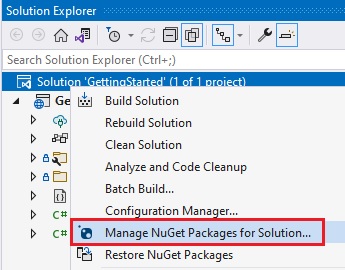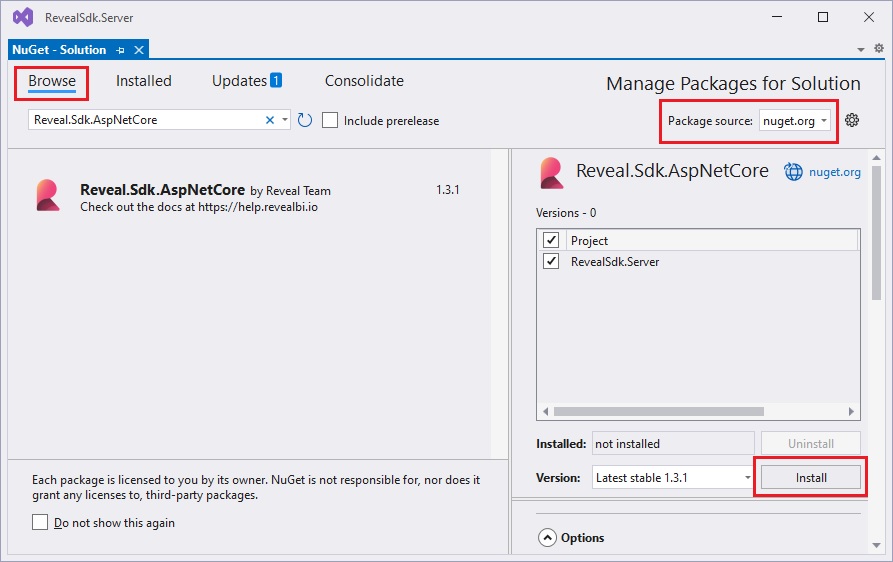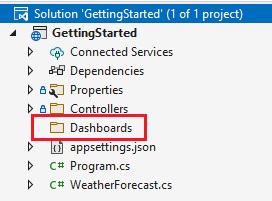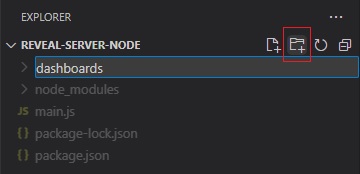Installing the Server SDK
ASP.NET
The steps below describe how to install the Reveal SDK into an existing ASP.NET Core project.
1 - Right click the Solution, or Project, and select Manage NuGet Packages for Solution.

2 - In the package manager dialog, open the Browse tab, select the nuget.org package source, or the Infragistics (Local) package source is available, and install the Reveal.Sdk.AspNetCore NuGet package into the project.

3 - Open and modify the Program.cs file to add the namespace using Reveal.Sdk;. Then, add the call to IMcvBuilder.AddReveal() to the existing builder.Services.AddControllers() method as follows:
using Reveal.Sdk;
builder.Services.AddControllers().AddReveal();
4 - Right-click the project and select Add -> New Folder. The folder MUST be named Dashboards .

By default, the Reveal SDK uses a convention that will load all dashboards from the Dashboards folder. You can change this convention by creating a custom IRVDashboardProvider. You can learn more about this in the Loading Dashboards topic.
Node.js
1 - Install the Reveal SDK for Node.js
- npm
- Yarn
- pnpm
- Bun
npm install reveal-sdk-node
yarn add reveal-sdk-node
pnpm add reveal-sdk-node
bun add reveal-sdk-node
2 - Modify the main.js file to add Reveal
var express = require('express');
var reveal = require('reveal-sdk-node');
const app = express();
app.use('/', reveal());
app.listen(8080, () => {
console.log(`Reveal server accepting http requests`);
});
3 - In Visual Studio Code, click the New Folder button in the Explorer and name it dashboards. The folder MUST be named dashboards

By default, the Reveal SDK uses a convention that will load all dashboards from the dashboards folder. You can change this convention by creating a custom IRVDashboardProvider.
Java
The steps below describe how to install the Reveal SDK into an existing Java application.
1 - Update the pom.xml file, and add the Reveal Maven repository.
<repositories>
<repository>
<id>reveal.public</id>
<url>https://maven.revealbi.io/repository/public</url>
</repository>
</repositories>
2 -Add the Reveal SDK as a dependency.
<dependency>
<groupId>com.infragistics.reveal.sdk</groupId>
<artifactId>reveal-sdk</artifactId>
<version>1.8.2</version>
</dependency>
Spring Boot - Jersey
Create a Jersey Config class and initialize the Reveal SDK by calling the RevealEngineInitializer.initialize method. In order for the Reveal SDK to function properly with Jersey, we need to register all of the Reveal SDK classes with Jersey. To register the Reveal SDK classes, loop through the classes returned by the RevealEngineInitializer.getClassesToRegister method, and register them with the Jersey Config.
import org.glassfish.jersey.server.ResourceConfig;
import org.springframework.stereotype.Component;
import com.infragistics.reveal.engine.init.RevealEngineInitializer;
import javax.ws.rs.ApplicationPath;
@Component
@ApplicationPath("/")
public class RevealJerseyConfig extends ResourceConfig
{
public RevealJerseyConfig()
{
RevealEngineInitializer.initialize();
//register all Reveal classes in JAX-RS context
for (Class<?> clazz : RevealEngineInitializer.getClassesToRegister()) {
register(clazz);
}
}
}
Tomcat
1 - Add a dependency to a Jakarta RESTful Web Services (JAX-RS) implementation. You can choose between multiple options like Jersey, RESTeasy, Apache CXF, etc. Please follow the steps described by the provider of your preference.
As an example, here the dependencies you need to add for Jersey:
<dependency>
<groupId>org.glassfish.jersey.containers</groupId>
<artifactId>jersey-container-servlet</artifactId>
<version>2.32</version>
</dependency>
<dependency>
<groupId>org.glassfish.jersey.inject</groupId>
<artifactId>jersey-cdi2-se</artifactId>
<version>2.32</version>
</dependency>
2 - Create a ServletContextListener class and initialize the Reveal SDK by calling the RevealEngineInitializer.initialize method.
import javax.servlet.ServletContextEvent;
import javax.servlet.ServletContextListener;
import javax.servlet.annotation.WebListener;
import com.infragistics.reveal.engine.init.RevealEngineInitializer;
@WebListener
public class RevealServletContextListener implements ServletContextListener {
@Override
public void contextDestroyed(ServletContextEvent ctx) {
}
@Override
public void contextInitialized(ServletContextEvent ctx) {
//initialize Reveal
RevealEngineInitializer.initialize();
}
}